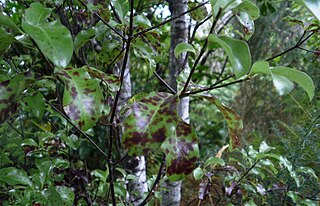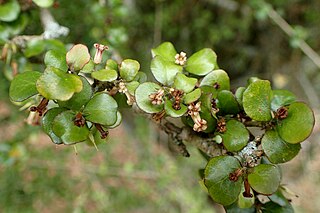Mock orange or mock-orange typically means Philadelphus, a mostly Holarctic genus of shrubs, particularly the species Philadelphus coronarius which is widely cultivated as an ornamental.

Pittosporum is a genus of about 200 species of flowering plants in the family Pittosporaceae. The genus is probably Gondwanan in origin; its present range extends from Australasia, Oceania, eastern Asia and some parts of Africa. Citriobatus can be included here, but might be a distinct genus. They are commonly known as pittosporums or, more ambiguously, "cheesewoods".

Pittosporum tenuifolium is a small evergreen tree, up to 10 m (33 ft), native to New Zealand, commonly known as kōhūhū and black matipo, and by other Māori names kohukohu and tawhiwhi. It is sometimes grown under the cultivar name 'Nigricans', so called because of its black stems. In horticulture it is valued for its coloured foliage, and for its tolerance of some horticulturally difficult growing conditions, including dry soils and shade. The flowers generally go unnoticed because of their colour, a very dark reddish-purple, and are scented only at night. It is found growing wild in coastal and lower mountain forest areas up to an altitude of 900 m. The Latin tenuifolium means "slender-leaved".

Pittosporum undulatum is a tree growing to 15 m tall with wavy (undulating) leaf edges. It carries conspicuous orange woody fruits about 1 cm in diameter for several months after flowering in spring or early summer.

Pittosporum coriaceum is a species of plant in the Pittosporaceae family. It is endemic to Macaronesia, and due to extinction in the Canary Islands, it is now restricted to the Portuguese Madeira Islands.

Pittosporum napaliense, the royal cheesewood, is a species of plant in the Pittosporaceae family. It is endemic to Hawaii, where it is known only from northwestern Kauai. It became a federally listed endangered species in 2010.

Pittosporum obcordatum, commonly called heart-leaved kohuhu or heart-leaved kohukohu or kohukohu, is a species of plant in the Pittosporaceae family. It is endemic to New Zealand, and exists both in North Island and South Island.
Pittosporum patulum is a plant species endemic to New Zealand where it has a restricted distribution in the South Island - ranging from Nelson in the north with occurrences in inland Marlborough down to Wanaka in the south. It is unusual amongst the genus in having deep red and scented flowers.
Pittosporum terminalioides, the cream cheesewood, is a species of plant in the Pittosporaceae family. It is endemic to Hawaii. It is threatened by habitat loss.
Pittosporum turneri, commonly called Turner's kohuhu, is a species of plant in the Pittosporaceae family. It is endemic to New Zealand.

Pittosporum eugenioides, common names lemonwood or tarata, is a species of New Zealand native evergreen tree. Growing to 12 m (39 ft) tall by 5 m (16 ft) broad, it is conical when young but more rounded in shape when mature. Its leaves are mottled yellow-green with curly edges and a salient bright midrib, and have a strong lemony smell when crushed. It has highly fragrant clusters of attractive yellow-cream flowers in spring, followed by distinctive black seed capsules. It is found throughout New Zealand's North and South Islands along forest margins and stream banks from sea level to 600 m (1,969 ft). It is New Zealand's largest Pittosporum.

Pittosporum revolutum, the rough-fruited pittosporum, yellow pittosporum, Brisbane laurel or wild yellow jasmine, is a shrub that is endemic to Australia. The species grows up to 3 metres in height and has leaves that are 5 to 15 cm long and 1.5 to 6 cm wide.The fragrant, yellow flowers appear in terminal clusters in spring. It occurs in habitats ranging from rainforest to dry sclerophyll forests in Queensland, New South Wales and Victoria.

Pittosporum tobira is a species of flowering plant in the pittosporum family Pittosporaceae known by several common names, including Australian laurel, Japanese pittosporum, mock orange and Japanese cheesewood. It is native to Japan, China, and Korea, but it is used throughout the world as an ornamental plant in landscaping and as cut foliage.

Pittosporum bicolor, commonly known as cheesewood or banyalla, is a flowering shrub or small tree of the Pittosporaceae family, and is native to south eastern Australia.

Rhytidosporum procumbens, commonly known as white marianth, is a small perennial plant of the pittosporum family, Pittosporaceae. The species is endemic to south-eastern Australia. It has narrow leaves that are 5 to 20 mm long and 1 to 1.5 mm wide. White flowers appear in spring.

Pittosporum angustifolium is a shrub or small tree growing in inland Australia. A slow growing plant, usually seen between two and six metres high, though exceptional specimens may exceed ten metres. Common names include weeping pittosporum, butterbush, cattle bush, native apricot, apricot tree, gumbi gumbi, cumby cumby, meemeei, poison berry bush, and berrigan. It is drought and frost resistant. It can survive in areas with rainfall as low as 150 mm per year. A resilient desert species, individuals may live for over a hundred years. A revision of the genus Pittosporum re-instated this species the year 2000.

Pittosporum phillyreoides, with the common names weeping pittosporum and willow pittosporum, is a shrub or small columnar tree in the Apiales order, endemic to Australia.
Pittosporum ceylanicum is a species of plant in the Pittosporaceae family. It is endemic to Sri Lanka.
















